-
Mental ResilienceWhy do you think inheritance plays such a strong role? — Agustino
Traits for one thing, and how we get them for a second are not all that well understood yet. For instance, if some one is inflexible and easily agitated, is that a feature of the endocrine system (too much adrenaline aka epinephrine produced) or is it a problem of interpreting sensory information to recognize threat? Or maybe an insufficient amount of cortisol (activates antistress and anti-inflammatory pathways) is a contributing factor. The function of the adrenal glands is genetically controlled. The way sensory information is interpreted could also be inherited. Our primate relatives, and I think ourselves, are pretty much quite ready to fear snakes and spiders--because both of them have posed an existential threat for about as long as mammals have been around. Well, polar bears haven't had to worry too much about snakes and spiders. So far, anyway. We have to work hard to learn how to tolerate or like snakes and spiders. Most people don't learn that tolerance.
Another reason for thinking that inheritance is important in the way people behave is that the organization and function of the brain is genetically guided and controlled, and normal brains all seem to work pretty much alike. Considering 1000 people with normal brains and normal upbringing (weren't raised by braying jackasses), they seem to fall into groups: excitable; pessimistic; optimistic; resilient; fragile; calm; nervous... and so on. Obviously the circumstances of one's life influences this. Someone who has been subjected to an abusive childhood, or experienced torture or severe battle trauma, and the like are not going to be just like everybody else. Still, of 1000 people experiencing severe battle stress, many? some? will not have PTSD.
Conversely, some people with a high IQ, good childhood rearing, excellent education, and parents who know how to advance an offspring's career, still don't amount to much. It isn't that they can't -- they just are not interested in life's competitive race. And there are people who don't have all these advantages but have a lot of ambition and 'sitzfleisch" (can sit still till a difficult task is completed) who do quite well.
Generally people want to give themselves credit for their successes and blame something else for their failures; but I think success is somewhat dependent on factors one can't control--like having ambition.
No one can build an airtight case for inheritance at this point, but it seems to me to be tighter than the case for chalking everything up to voluntary characteristics, will power, preferences, learned behaviors, and so on. -
Mental ResilienceBut there are people like Stephen Hawking, who don't seem to be either interested in religion,n or philosophy nor meditation - so maybe mental resilience cannot be attributed to those factors, — Agustino
"My disability freed me from a lot of ordinary activities and allowed me to spend long periods of time thinking deeply about physics", he said. If he was optimistic and resilient, this was perhaps a gift of inheritance. There are just a few emotional/affective models for us -- resilient, fragile, reactive, imperturbable, calm, excitable, hostile, friendly, stingy, generous... and in combination with intelligence and verbal prominence, account for a lot of what we are.
One might add that Hawking had an built-in delay mechanism between a thought and a feeling and its verbal expression. If it took me 30 minutes to compose an angry sarcastic comment on the computer, there are a lot of things I would never have said or written, and the feedback loop of saying them wouldn't have existed. (Hawking's life had some troubled elements, apparently -- not surprising for any human. He divorced and noted that one of his wives (can't remember which) had been abusive, for instance.)
So, perhaps between a natural born resilient personality and lots of time to think about what he liked to think about, he lived well.
I know I don't have as resilient a personality as some people's. I am more reactive and am more agitated than some. When I can manage my life to incorporate lots of time alone, reasonably pleasant activity (like enjoyable work), I do quite well. There have been times when I couldn't arrange that, and life was very stressful for large blocks of time. In this respect, I am much more like my mother than my father. Three of my six siblings are like our mother, three are like our father (in the category of resilience).
I have found that mediation and religion have been only somewhat helpful. But so have really good books and great music been helpful. -
Beautiful StructuresWhy did they change the name of the Triborough Bridge to the RFK? — T Clark
It says they changed it at the request of the Kennedy family.
So, just like that. Somebody at Kennedy HQ picks up the phone and calls Mayor Bloomberg and says, "you know, we'd like the Triborough named after Bobby. Don't you think that would be nice? When will the new plaque be ready?" (It was in... 2008?) -
Beautiful StructuresIs this in South America? I suppose the ants on the underside of this bridge manage not to drown, or not?
Leiningen Versus the Ants -- great story.
It seems like there is a large hairy bushy-tailed animal menacing the abandoned termite mound.
Now, it says that fireflies are beetles. Didn't know that. But they don't feed much as adults (which is when they do their light thing, I suppose) but they are vicious predators when larvae -- they throw up stomach acid on their prey. That would make a great horror film.
I commend the bower bird for it's excellent taste in blue plastic. -
Beautiful StructuresHere we have a man on his knees in the snow apologizing to a woman he hardly knows for making a possibly inappropriately sexually suggestive comment. You can't be too careful these days. She might have just grabbed him and thrown him off the bridge. And gotten away with murder!
The pile in the background is Minneapolis.

-
Beautiful StructuresHouses, skyscrapers, bridges — T Clark
If you like bridges, you might like the 'Stone Arch Bridge' across the Mississippi in Minneapolis. It was built by James J. Hill for the Great Northern Railroad in 1883. It served railroad traffic until 1978. By then passenger service had ceased and the large Great Northern station had been torn down. Freight traffic was routed on other lines that didn't go through the middle of DT Minneapolis. It's about 2100 feet long and 38 feet wide. It's the only stone-arch bridge on the Mississippi.
Today it's part of a very popular bike/walking trail and historical park scene.

The SAB is next to the former center of Minneapolis's flour milling industry. Water from above St. Anthony Falls was piped to turbines which drove milling equipment. Shown here are the out-fall streams from the turbines. All of those mills are now gone, though the foundations are buried under the West River Road embankment.
This is the site where Gold Medal and Pillsbury flours were once milled and shipped to a store near you. Milling is now done elsewhere.
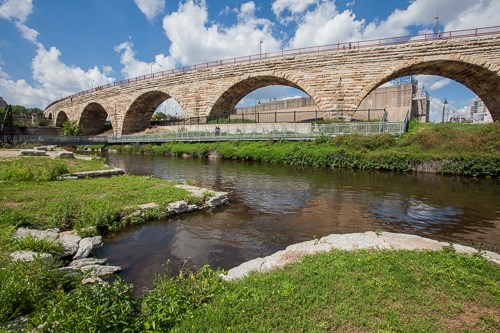
-
Beautiful StructuresI don't see an emoji in your post. — T Clark
Why should you?
After second grade we were moved to a cheesy new elementary school building in like...1955. They attached it to this old building and to the high-school which was built by the WPA in the '30s. They recently tore it down, much to everyone's relief. Nobody misses it. That's a sign of bad architecture. -
Beautiful StructuresHere's a picture of my hometown in 1890, about. These two blocks on opposite side of the road are partially intact. The park is still there.
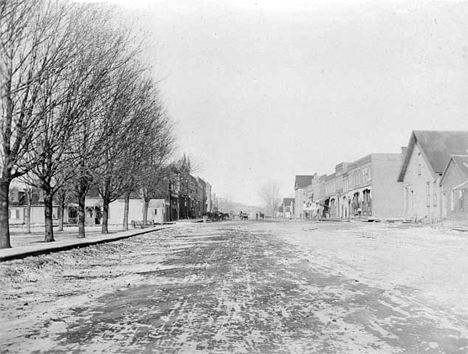
A few years later, around 1900-1910, the place was looking a lot more prosperous.
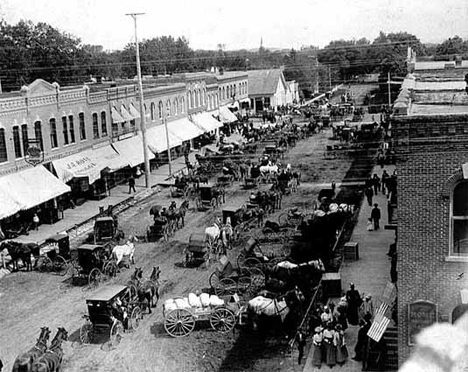
Here's the place quite recently.

I attending first and second grade in this nice old brick and limestone building with slate roof and copper trim. After second grade I was dragged off to work in the iron mines of SE Minnesota with just my little pick, shovel, and little tin pail. Life was cruel back in the 1950s. People don't realize how much we suffered. It was salvaged in the 1960s--taken apart for the fine old-growth lumber in it, and nicely cut limestone. There were only 8 rooms -- but big, with very high ceilings. Maybe it could have been adapted for some use (don't know what, really). Salvage was probably the best way to reuse it.
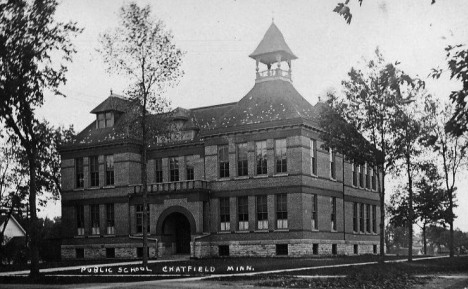
Chatfield has a Carnegie Library. It had a distinct bookish odor to it. It's still there, but has had an architecturally appropriate addition.
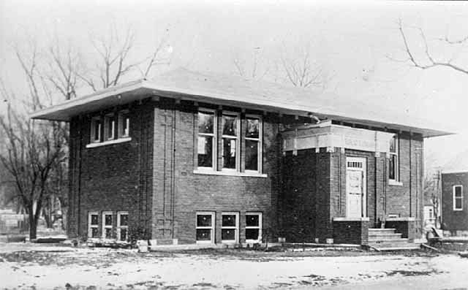
-
Beautiful StructuresIf you like rail trails and find yourself trapped in SW Wisconsin with nothing to do, check out the Elroy Sparta Trail, the FIRST rail to bicycle trail project in the country. It's about 30 miles long and has 2 or 3 tunnels, one about 3/4 miles long. The trail follows a piece of the Chicago and North Western Railroad trackage. CNW became part of Canadian National Railroad. Of course the tunnels are dark, so you can walk through in the dark. there are drainage gutters on each side of the trail in the tunnel. Wisconsin is beautiful in the fall.
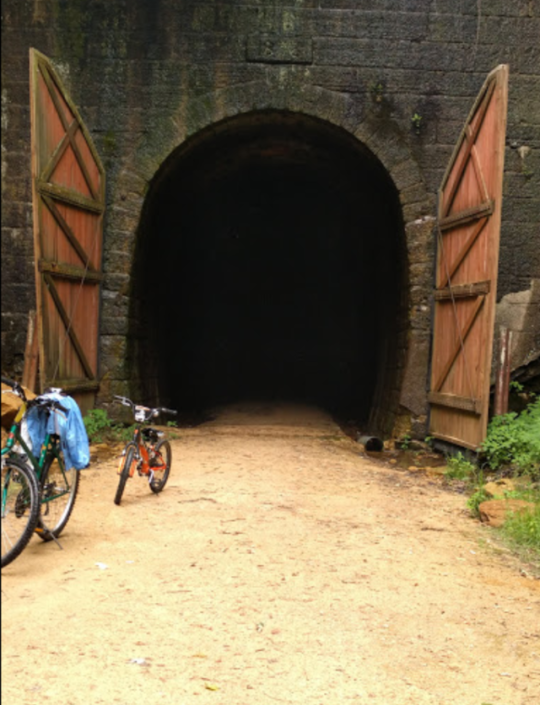
There is a modest trail fee. -
Christianity: not stupidReligion is all but obsolete — SnowyChainsaw
All I am trying to say is that Religion discourages critical thinking. It does this by claiming it already has all the answers — SnowyChainsaw
If I were a faithfully religious person, I would quarrel with you. That seems pointless since I have been pitching overboard as much of the protestant religious baggage I can stand to lose that I have carried around for the last 7 decades. There are religious groups that make my skin crawl, but then there some that are kind of pleasant to hang around with. It depends on the specifics of the people involved.
People seem to need some kind of "religion" on which to organize their experiences, hopes, aspirations, disappointments, failures, dreams, nightmares, tedious or exciting experiences, and so on. I do disagree with you that "religion" is obsolete.
It isn't obsolete because human beings have not changed in fundamental ways in the last couple hundred thousand years and we haven't achieved super-rationality. It doesn't look like super-rationality is just around the corner, either. So... religion of some sort is probably going to last quite a while yet.
What has changed in the last two or three hundred years are industrial, scientific, and cultural revolutions that have granted us the possibility of much more insight into our Situation, which is available to the extent that we are willing to accept it. That has done a great deal to undermine religion and religious satisfaction.
Some people haven't accepted much of the insight at all, and it is among that quite large group that you will find the rigid, doctrinaire, dogmatic, judgmental folk who tend to be hell on roller skates, if they get half the chance.
Religions' replacements will probably first appear as secular systems, like socialism/communism/marxism. "We'll build the city on the hill through revolution, from each according to his abilities, to each according to his needs", and everything will work out just fine. Right.
Or maybe the replacement for some will be Free Markets in the Global Economy. Or Through Science all problems will be solved and we will all live happily ever after. Or maybe some new hogwash like Scientology will conquer all.
Whatever it is, it will have to provide people a satisfying framework in which to exist, and so far, at least, the old time religions seem to be better than the new-fangled replacements -- for those who want them, at least. -
Christianity: not stupidStreet view is pretty amazing. Not taking the actual video of a given street, but storing this huge mass of data in such a way that Google can deliver a clear video image of a drive down one of millions (millions?) of streets, and can serve it up in just a few seconds.
-
Christianity: not stupidBut the ideas contained in them, where do they really come from? — Sir2u
Why, God -- of course!
Joking, of course.
In The Ruin of the Roman Empire, A New History by James J. O'Donnell, the author observes that after the Babylonian Captivity, when the Persians sent the Judeans back to Jerusalem, the holy scriptures were "rediscovered". O'Donnell asks, just how were the scriptures suddenly re-discovered, and what, exactly, did they (Ezra et al) rediscover??? O'Donnell doesn't know, and of course nobody else knows what they rediscovered either. The Babylonian captivity was a major disruption in Jewish religious continuity.
I suppose a remnant of the Judean population remained, and over the course of a couple of generations they kept a copy under a rock somewhere. Or maybe the Samaritans who weren't taken away, kept a copy for them, under a different rock.
My honest answer is that over time various creative people made the scripture up -- everything from "In the beginning..." down to the Apocryphal books. They sat there, composed in their heads, and then delivered well-honed texts at the appropriate time. People used to be able to do that; then writing came along and pffft: Ability gone. After that they had to use lambskin or papyrus to compose. Or clay tablets. All very clunky compared to a Mac desktop.
Just like people used to be able to find their way around the block before GPS devices were put in cars. -
Identity Politics & The Marxist Lie Of White Privilege?I was hoping that you'd chime in and provide some decent historical context, it was why I included the needle exchange thing as an example. — fdrake
Thanks for your confidence, but it has been quite a while since I have observed much about needle exchange.
What I saw, public health outreach, was welcome by IVDUs, because they recognized the risk (not always, but quite often) and it was offered without judgement. It's surprising to me that needle exchanges aren't common place, even ubiquitous. At least I see needle and other 'sharps' disposal units in a lot of washrooms where one wouldn't expect to find them. The last iteration of needle exchange I witnessed was a mobile operation where drug users could either visit the needle exchange van and get what the needed (plus testing, at certain times) or could arrange a visit somewhere with the van driver.
The better approach is "safer shooting galleries" which also are generally a public health approach and which run into more legal barrier than needle exchanges do. The safer shooting galleries do not offer drugs, they offer clean works and a safe place to enjoy the high, and someone on hand with Naloxone (or similar opiate receptor antagonists), should it be needed--which it quite often is.
The final approach to safer drug use is providing the kit and caboodle--works, drugs, setting--the whole thing. This relieves the addict of health risks, and avoids the criminal activity often required to get money for drugs. I don't think anybody in the US is doing this at this point. There are at least a few groups that would offer all this if they could get approval and funding.
Peer generated efforts are difficult because the peers are engaged in criminal activity to start with, and can't just show up at a city, county, or state health department and ask for money to start a program. They wouldn't be considered creditable by themselves. The health departments themselves are staffed by understanding, thoughtful professionals who none-the-less have their limits. The relevant staff may not want to get too deeply involved with IVDUs. Non-profit agencies have to be recruited, and there one finds the same reluctance to get too involved, and fears of PR disasters.
The take-away message on AIDS prevention is that it isn't going well. It isn't that nobody knows how to do HIV prevention education, doesn't know how to reach vulnerable groups (like young black gay men), isn't capable of creating effective messages (or finding someone who can), or can't find people willing to do the leg work on the street and in neighborhoods.
This limp wrist or limp dick approach starting appearing in the late 1990s with just really very mediocre education efforts replacing what had been more vigorous efforts; Then under George Bush doing education got more difficult because of more scrutiny and oversight demanded by the federal government. Material, for instance, had to be reviewed to make sure it wouldn't offend anybody. A fatal requirement. Sexual health messages that get to the point will definitely offend someone.
It's like there is a "failure of will" on the part of both public health people and communities. The statistics are clear that new infections are occurring regularly, despite there being reasonably effective to very effective methods of preventions -- condoms or a daily Truvada pill, an AIDS drug that when taken by the uninfected, prevents infection by the virus by suppressing reverse transcriptase). The cost of prevention is always less than the cost of treatment when someone gets infected.
I must admit that if I were 30 and sexually active, (sigh) I would hesitate to commit myself to taking Truvada every day for maybe 20 or 30 years. It isn't terribly dangerous, but it can have serious side effects, and it doesn't eliminate the need for condoms--for either HIV or other STDs.
Here's a CDC bar graph on 2016 infections:

-
Identity Politics & The Marxist Lie Of White Privilege?You didn't ask me, but... what the hell. Some of it is "identity" and some of it isn't.
Take the gay marriage issue. It wasn't part of the initial gay liberation agenda, even if a few gay people tried to marry as early as 1970. It didn't get major traction until much of the "acceptance" items on the agenda had been won. Gay advocacy could have stopped there. "Advocacy" is beneficial, but it is also a raison d'être and if the gay agenda had been met, what further need would there be for advocates? Little to nothing. Marriage was pushed to the fore, and grafted on to the liberation agenda, even if this sort of assimilationist move was contrary to the original "liberation" idea. As gay marriage became acceptable, transsexuals became the cause-celebre. It has never seemed to me that transsexuals seeking a medical solution (drugs, surgery) to their alleged problem were ever a natural part of gay liberation. None the less, here we are.
Needle exchanges? Night classes? Ending apartheid? No, I don't think these are identity-motivated. For one, a good deal of the drive to implement needle exchanges comes from the public health agencies. Many of the workers in these programs are not IVDU, though some are, or were. Rather than an identity movement, I see it more as "applying social marketing technology". Some people who start free evening classes no doubt below to the target audiences, but a lot of those programs are staffed by people who don't belong to the target group. Again, it's a well practiced social up-lift strategy with a history back into the 19th century. Apartheid? Most of the people I've seen agitating against apartheid were white Americans who didn't have much connection to South Africa. It is a good thing that white activists opposed apartheid, but I don't think opposition was based on identity.
Self Help programs generally are ethnicity based--because they arise out of a specific community. The gay response to AIDS was identity based self help. Organizing west coast agricultural workers and the grape boycott was self help with an ethnic base. The National Farmers Organization (now long gone) was a rural white-ethnic based agricultural self help drive. The civil rights movement was a black ethnic self help movement. -
Identity Politics & The Marxist Lie Of White Privilege?So: anything based on good, old-fashioned Marxism — gurugeorge
Well, blame who you will, but I don't think "old-fashioned Marxism" is a very good culprit. It's more likely new-fangled Marxism that is source of the nonsense. That and critical theory, POMO, and all that stuff.
Marx wasn't a 'splitter' he was more of a 'lumper'. He looked at 'lumps' like the bourgeoisie and the working class; he didn't split up the 'lumps' into all of the imaginable divisions like white working class, black working class, hispanic working class, female working class, male working class, undocumented working class, jewish working class, urban working class, suburban working class, rural working class, young working class, middle aged working class, old working class, lazy working class, ambitious working class, and so on and so forth.
The current fixation with identity is the province of obsessive-compulsive splitters. It isn't enough to separate out homosexuals and heterosexuals; there are gays, lesbians, bisexuals, transsexuals, queers, and don't-know-their-ass-from-their-elbow-sexuals. Transexuals magically split into... 10? 50? 100? different versions, some comprising less than 1 person (some twit who has mixed feelings). Every conceivable ethnic, racial, or geographical feature can be used as a wedge to further split things down as far as possible.
Have you heard of "games of uproar"? I think the SJW types, so called, like games of uproar. The splitters expose many new surfaces on which conflict can be imagined, if not observed, and by exaggerating everything, they can fuel their needs for excitement in these games of uproar. -
Christianity: not stupidBut did the Jews actually write it directly from the source they claim or copy it from somewhere else?
There are plenty of creation myths about and some contain elements similar to the one in the bible. — Sir2u
Yes, of course. We can assume that parts of the Jewish scripture were 'accumulated' from tribal sources, some of it was borrowed, and some of it was composed, and some of it developed from liturgical practice. The same thing is true of the New Testament.
But that isn't the question I was addressing. I said "the Jews never stopped reading their sacred work". Whenever, however, wherever it was composed, accumulated, borrowed, or developed, the Jews used the texts in Judea and took the texts with them into the diasporas. The synagogues preceded and survived the destruction of the Temple and, and it was in the synagogue that scripture usage was maintained.
There was no major break in the tradition and use of scripture -- it isn't like the scripture was lost in 100 BCE and then rediscovered in 500 CE or 1500 CE.
Christian Gnostic writings, or the 'Dead Sea Scrolls' met a fate of loss and rediscovery, but the Jewish and Christian Bible didn't meet such a fate. -
Sergei Skripal: Conspiracy or Not?If you think I speak like a true trumper, then you have perceived nothing about anything I have written. Plus, you aren't very good with non-literal statements. Kind of a sour-puss, actually.
-
Sergei Skripal: Conspiracy or Not?In the case of 9/11 there's a lot of unanswered questions in regards to how a modern steel framed building could have collapsed symmetrically and at free fall speed, with all the steel columns supporting the building turning into cheese. — Posty McPostface
WTC 7 was, I assume, a conventional steel frame building. WTC 1 and 2, the two big ones, were not. The big buildings weren't supported by interior steel or concrete columns. The floors were supported by the exterior steel walls of the building. The concrete floors were attached to the exterior, and within the floor structure were 'ties' that connected opposing exterior walls to add rigidity to the building.
The fires on and above the floors struck by the planes weakened the ties. The weight of the building floors in and above the fire, caused the exterior supporting structure to bulge, and begin to break away from the ties and the concrete floor--not instantly, but fairly quickly. When the weight exceed the support capacity of the bulging exterior walls, the x number of floors descended straight down (why would they not?) and overwhelmed the support capacity on the next floor, and the next floor... all the way to the bottom.
The 911 attackers did not need to plan this out--and as far as I know, they didn't expect the towers to collapse. They wanted to severely damage the WTC towers, and they would have totally succeeded if the building hadn't collapsed, and the fires had been put out. If they did plan pancaking, then they were that much more ingenious.
You are suspicious of steel giving way. Steel, as it happens, isn't heat resistant the way concrete is, or wood for that matter. The ties had been coated, but not heavily, and the shock of the crash caused much of the coating to fall off. Bear in mind, the ties were not heave H shaped supporting beams--they were rods, very strong, but not big enough to resist any force.
You are probably correct that a building constructed with the usual forest of steel columns would not have collapsed symmetrically, under the conditions of WTC 1 and 2.
WTC 7 was damaged in two ways: first by heavy debris from the collapsing towers, then by fire. The building did not weaken symmetrically, it was sagging and bulging before it collapsed. I haven't read or heard that much about WTC 7, so I can't say more about it.
911 was the second WTC attack. In 1993, if you remember, a truck bomb loaded with urea-nitrate explosives enhanced with hydrogen gas was detonated in the garage under the North Tower (can't remember if that was WTC 1 or 2--doesn't matter). The intention was to tip the North Tower over into the South Tower and cause both of them to hit the ground, killing a whole lot of people.
The truck bomb didn't happen to be just quite properly located to achieve the intended result. Had it been located in just the right place, the plan would probably have worked.
WTC 7 had a similar vulnerability. Certain support beams were critical in maintaining whole-building stability. Why would this be the case? Because of remodeling, design changes, and the required engineering changes needed to achieve stability. As it happens, the vulnerable support structures were damaged, contributing to the collapse.
From a conspiracy theorist POV, all this is probably unsatisfying because it leaves blame too diffused. Engineering decisions, lack of water pressure, electrical failures (no pumps), not enough insulation on rods, and so on and so forth.
Climate change conspiracy theorists think that global warming is a hoax for, I suspect, similar reasons. Blame is so diffused that there is no guilty party to pin it on. 300 years of coal and oil burning leaves a lot of guilty parties -- like, just about everyone. So, they reason, it must be a hoax.
You might be interested in a New Yorker Magazine story about the City Bank Building in NYC -- the one with the steeply canted roof and asymmetric supports at street level. The architect of the building had been thinking about the building, one fine day, and was thinking about what kind of fasteners were supposed to have been used to attach X-shaped structural members together. They were supposed to have been welded. When he checked it out, he found -- much to his horror, that they had not been welded, the bolts had been screwed into place. Fixing this wouldn't be easy, because the building was finished and occupied. He didn't think the building as it stood would be able to withstand an unlikely--but quite possible--hurricane force storm.
He alerted the building owners immediately, and crews began the process of opening up the walls over the X structures, one by one, floor by floor, and welding the many many bolts--this all being done at night so as not to disrupt bank operations. Then the walls had to be closed and refinished. God, think of the overtime! -
Christianity: not stupidAs much as someone steeped in mainline Protestant Christianity and who found it useful can, I call myself an atheist. But I didn't throw the baby Jesus out with the baptismal water--so to speak. I'm way too old now to reorganize my personality, so Christianity remains part of my 'operating system' but I find it necessary to do without the belief system. It's something of a relief.
I agree that Christianity is THE primary contributor to western civilization, not in a straight line from Jesus to Thomas Jefferson, of course. Not even in a very crooked line between the two. Too much happened over those 2000 years. -
Christianity: not stupidTen thousand years from now, after the destruction and rebuilding of civilization a couple of times, they might dig up a collection of Harry Potter books and decipher the unreadable scrawling on the page. — Sir2u
The thing about the Bible (and other writings from the ancient world) is that they are not 10,000 years old, and civilization hasn't been destroyed and rebuilt a couple of times. There is quite a bit of continuity in the culture of the last 2500 years which makes these texts (not just the Bible) accessible and meaningful.
The Jews never stopped reading and using their sacred writings. -
Christianity: not stupidBut then you have to account for all of the excellent colleges and universities that were started by and are run by Christians. Apparently it is possible to be intellectual and Christian, and secular all at the same time.
-
Sergei Skripal: Conspiracy or Not?I'm aware that the promoters of this forum grown upon it; but, the manner in which people respond to "beliefs that they do not share" or otherwise pejoratively called "conspiracy theories" leaves much to be desired. — Posty McPostface
Reasonable, and reasoning people--like yourself--react to conspiracy theories negatively because there is a "reality-challenging" pattern to the theories. Bad things happen that aren't readily explainable, and certain kinds of people find the ambiguity of the inexplicable very uncomfortable. To relieve the ambiguity they come up with theories that fit.
In November of 1964 Kennedy was fatally shot in Dallas. A man, Lee Howard Oswald, was apprehended the same day. A day or two later, another man, Jack Ruby, walked up to Oswald while he was being moved and shot Oswald to death on live television.
There were two official theories investigated -- the lone shooter and two shooters--Oswald and a second shooter. It had been quite a long time since a president had been assassinated, and people were shocked and appalled that such a thing could happen, and the investigation was long and exhaustive.
The assassination conspiracy theories were not a new phenomena, of course, but given the enormity of the event, they were given extraordinary play. The usual pattern applied.
#1 a priori assumption: the government is lying. #2 a priori assumption: the government actually did it.
This just could not be the act of a loner. This was a big operation. Actually, the CIA/FBI were behind the assassination, for their own devious purposes. Oh, no: This is clearly a mafia operation, in payment for disrupting the gambling operations in Havana. Baloney, others said, this was definitely a Cuban-Soviet plot. And so on.
And always, the government is not telling the truth -- even though several exhaustive investigations took place. Yes, but they were led by the government, so what do you expect? It's all a coverup.
I'm quite sure, somewhere, some old farts are still nattering away about how the government covered up the REAL STORY of the JFK assassination.
Just 10 years later, give or take, there was an actual conspiracy--the various activities of the Nixon Administration to spy on, and screw around with the Democratic Party's election effort. The Committee to Reelect the President (later abbreviated as "CREEP") did various dirty tricks and, of course, broke into the Democratic National Party offices in the Watergate hotel complex.
When the conspiracy finally came to light, and was gradually dissected in long, broadcast pubic hearings, Americans got a clear picture of how conspiracies actually work. It was all much more straight forward than the typical conspiracy theory. -
Sergei Skripal: Conspiracy or Not?I do care about the nature of conspiracy theories -- not so much the content of the theories. The main problem with the content of the theories is that the theorists generally can't get their hands on solid evidence--which of course, helps the theorists since no evidence also means no limitations on speculation.
Here's an example of conspiracy with evidence: Several years before it was revealed just how much spying on American citizens by their own government was going on, there was a story in the New Yorker (if I remember correctly) written by a telephone switching equipment specialist. He was in the San Francisco telephone switching building where, among other things, a large number of long-distance and internet cables for west coast traffic were located. One of the floors had been locked and declared off-limits. This struck the specialist is passing odd. He had never seen a block of switching equipment put off limits. He managed to find a fellow union member who did have access to the locked floor, and was able to observe what was going on there.
What he found was a massive intercept on all of the west-coast cables--put there at the behest of somebody other than the telephone company. Later he learned that similar things were happening in other main switching centers. What he assumed was that somebody was vacuuming up the content of traffic. Who and why, he didn't know. But he had a theory.
He did think it was a conspiracy of some sort, but he had seen evidence of something secretive and very fishy going on. As I said, a few years later his hunch was validated by Edward Snowden.
Most conspiracies aren't supported by unusual observation prior to the event in question. For instance, no one observed crews working in the WTC buildings, opening up walls and attaching stuff to critical structures, and running wires from those "somethings" to somewhere else. Installing enough explosives to collapse three WTC buildings in the way we all observed it happening, wouldn't be something people wouldn't notice. It would be fairly complicated. -
Sergei Skripal: Conspiracy or Not?Nothing, what makes you think it is Russia. — René Descartes
Did I say I thought the Russians did it? I thought I said I didn't care who did it.
One of the features of conspiracy theories is to always discount the official explanation (like, 2 planes flying to the WTC towers) and reach instead for an obscure explanation that blames the source of the official explanation (the US Government did it with explosives). -
Sergei Skripal: Conspiracy or Not?What is Langley HQ anyway. — René Descartes
It's the headquarters of the Central Intelligence Agency in Langley, Virginia.
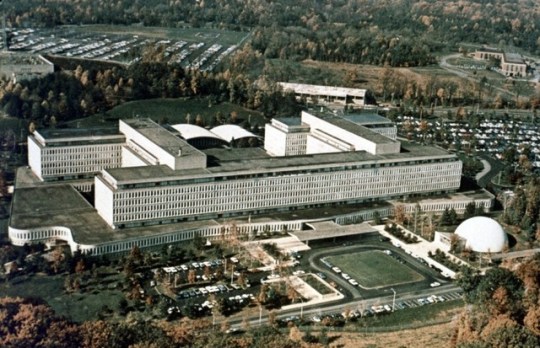
-
Sergei Skripal: Conspiracy or Not?Actually, I don't give a rat's ass about Sergei Scribal, his demise, and the motive or method employed to kill/execute/silence him and his daughter by whoever did it. That an exotic substance was used, instead of a gun, blunt object, blade, or bare hands doesn't make that much difference.
The thing is, what could you possibly bring forward that would actually clarify the identity of the agency which performed the killing and their motive? Conspiracy theories about 911 present the same problem: what could a bunch of even quite a bit above average Joes sitting in front of their computers possibly learn that would unravel the secret?
I will grant you that Ms. May could use something dramatic other than her own suicide to get her out of the Brexit negotiation mess. So... there is that. -
Sergei Skripal: Conspiracy or Not?René and Charlatan think they are freely engaging in a discussion of conspiracies. Obviously they don't know about the nano-sized implants in their brains, controlled by the CIA through satellite networks, like all those GPS devices which monitor EXACTLY where you are at all times...
They can't help but lip-sync to whatever music their masters in Langley HQ want them to dance to. -
The Book of JobArchibald Macleish wrote a play based on the book of Job, JB.
Plot summary
The play opens in "a corner inside an enormous circus tent". Two vendors, Mr. Zuss (evoking the chief Greek god Zeus; zuss is also German for "sweet") and Nickles (i.e. "Old Nick," a folk name for the Devil) [1] begin the play-within-a-play by assuming the roles of God and Satan, respectively. They overhear J.B., a wealthy New York banker, describe his prosperity as a just reward for his faithfulness to God. Scorning him, Nickles wagers that J.B. will curse God if his life is ruined. Nickles and Zuss then watch as J.B.'s children are killed and his property is ruined and the former millionaire is left to the streets. J.B. is then visited by three Comforters (representing History, Science, and Religion) who each offer a different explanation for his plight. J.B. declines to believe any of them, instead asking God himself to explain. Instead he encounters Zuss and Nickles. Nickles urges him to commit suicide in order to spite God; Zuss offers him his old life back if he will promise to obey God. J.B. rejects them both, and instead finds comfort in the person of his wife Sarah. The play ends with the two building a new life together. -
What exactly is communism?Communism is the withering away of the state; communism is the development of a knowledgeable working class (over time) which can take control from the bourgeoisie (the owners) of the economic resources of a country. The working class will have to take it, because the bourgeoisie are not going to just hand it over. That part could be a bit messy, depending on how tightly their fingers are gripping their property. (Hopefully it won't involve their cold dead hands.)
Without the state, without the bourgeoisie extracting surplus value from the workers (the profit, in other words), society will evolve to exploit the new economic circumstances. The demise of capitalism will not solve all problems, of course, and issues like global warming and environmental degradation are going to follow us to our graves, regardless of which political/economic system we have.
Still, I'd rather have a system friendly to the idea of "production for human need" rather than one based on "Production for maximum profit". -
What exactly is communism?Analogy: There are now 9 states that have nuclear weapons and a few more who could if they wanted to. The technology to make an atomic bomb was invented only once by the United States, 1942-1945, then a bit later for thermo-nuclear bombs. The technology was then stolen or shared.
There is similarly 1 state, the USSR, that established the first communist government and set the pattern. These two states shared their ideas and methodology with other states that also established communist governments in the PRC, North Korea, Cuba, and the eastern European bloc countries.
It has been pointed out many times that Russia was not a promising economy in which to apply Marxist thinking, but it none the less found enthusiasts well before the 1917 revolution. China was also not a promising economy.
The "flavor" of Soviet communism derived much from the personalities of its founders -- Lenin, Stalin, et al, and the project which they attempted to achieve: transform a very lightly industrialized agrarian economy with a long history of absolutist rulers, covering a vast territory populated by widely varying cultures, religions, geography, and so forth, into a heavily industrialized nation in a short period of time while engaged in two world wars, neither of which they started.
Both the USSR organized a very authoritarian governments (secret police and all) and operated a command economy (as opposed to a market economy) with the state serving as the Corporation. The State Corporation was not totally unsuccessful but it left much to be desired.
None of this is in Marx, Engels, or any major socialist/communist theorist. The Soviets (and others) tried for a giant leap-frog over the slow, historical development of a working class capable of seizing the means of production, and they failed miserably.
The results were both significantly good and really very bad. -
Identity Politics & The Marxist Lie Of White Privilege?There were indubitably acts of mass murder conducted by Sovet Russia and Communist China, among others. Doesn’t warrant hysteria but the fact remains. — Wayfarer
If war is diplomacy by other means, mass murder is social policy by other means. No one approves of it, but mass murder seems to have been a handy tool which has been reached for when more deliberative processes don't seem to be getting the job done.
That said, Stalin and Mao are both stand head and shoulders above the crowd of mass murderers, along with Hitler, and some others. But it wasn't communism, as far as I know, that led the US to pretty much wipe out native people. They were in our way, camping on valuable ground that, in our humble opinions, was not being put to its highest and best purpose--i.e., making America Great the first time around. The Japanese empire wasn't a communist operation either, as far as I know. Neither was the British Empire (killed a few, here and there) or the Spanish Empire (killed a few, here and there).
For that matter, it probably wasn't communism as envisaged by Marx and Engels and a batch of other early socialists/communists that drove Stalin and Mao. It was paranoia and bad policy -
Do You Believe In Miracles and/or The Supernatural?You also seem to agree with my basic position, that life itself is suffused with miracles and the supernatural - at least the active principle of life is. — Agustino
When you talk about miracles and the supernatural, aren't you references the actions of God? I am not. Chemicals, physics, and time produced life, and in time, intelligent beings, and at some point, just a few seconds ago in geologic time, God.
A theist could say that God brought all things into being through physical and chemical processes, and that the principle of life is the hand of God at work. If that's what you mean, fine; but that's not what I am saying. I am saying there was no directive hand, and that the processes of chemistry and physics could have ended up producing only rock.
The cosmos is a cold, frightful place, and we have found it a comfort to suppose that God is here (if not throughout an expanding universe). I believe God is our creation, brought into being to explain that which is intolerable to leave unexplained. That we are here is one of those things that requires a good explanation, and God does the trick for many. "In the beginning..."
I am quite sure that your use of the words "miracle" and "supernatural" does not signify the same thing that my use of the same words signifies.
This isn't criticism, just clarification. -
Do You Believe In Miracles and/or The Supernatural?I generally dislike that spiritual, mystical, and supernatural are often portrayed as some sort of medieval magic, and then dismissed right away. I also disagree with views that don't take into account the hidden, incoherent depths of unconsciousness. I'm not up for explaining anything just for the sake of seeming to have an answer. — Coldlight
I used to be a believer and engaged in talk of the spiritual, mystical, and supernatural. I never did, and I don't think of it as "medieval"--more like "normal". This thing, "spirit" and the quality of "spiritual" have an earth bound reality, at least the way I like to use the term. (And "spirit" has a long string of meanings, associations, and loose usages that can make the concept pretty much meaningless.) It is a feature of our minds that we can have experiences we call spiritual, mystical, and supernatural. Our mystical mind-bending experiences are cooked up somewhere in what you call "the hidden, incoherent depths of unconsciousness". It's where we live. Imagining God, creating God, striving to fulfill divine commands and follow the paths of Buddha or Christ or... are all profound creative acts. It is human. It is one of the things we do.
One has to decide how much reality one's God has. For billions of people, God is real, and since God isn't on hand to contradict our various, quite contradictory and highly inconsistent imaginations, the trick works. Imagining God doesn't make the deity a "fraud". (The charge of fraud, if warranted, will be laid against the creators, not the creation.) -
Do You Believe In Miracles and/or The Supernatural?Do You Believe In Miracles and/or The Supernatural? — Agustino
I do not.
But not believing in miracles and/or the supernatural doesn't mean living in a world which is not quite amazing.
If the cosmology of the big bang, 13.x billion years of time, a dust cloud that formed in this galaxy and produced this star, this solar system, this planet, this life is at least reasonably accurate, then our existence without miracles and the supernatural is still full of amazement.
Matter in its manifold complexity comprising all aspects of the physical world, including billions of minds, is not "mere". Looking for miracles in this world is "gilding the lily; it is adding cheap glitter to a sublimely complex, awful, wondrous, terrible, beautiful, beneficent, and even cruel and appalling reality. Existence is "super natural". There was once no existence; there was just matter.
That matter became life, without divine assistance, and evolved into the many beings of earth, is almost infinitely improbable, and one need look no further for miracles.
BC

Start FollowingSend a Message
- Other sites we like
- Social media
- Terms of Service
- Sign In
- Created with PlushForums
- © 2025 The Philosophy Forum